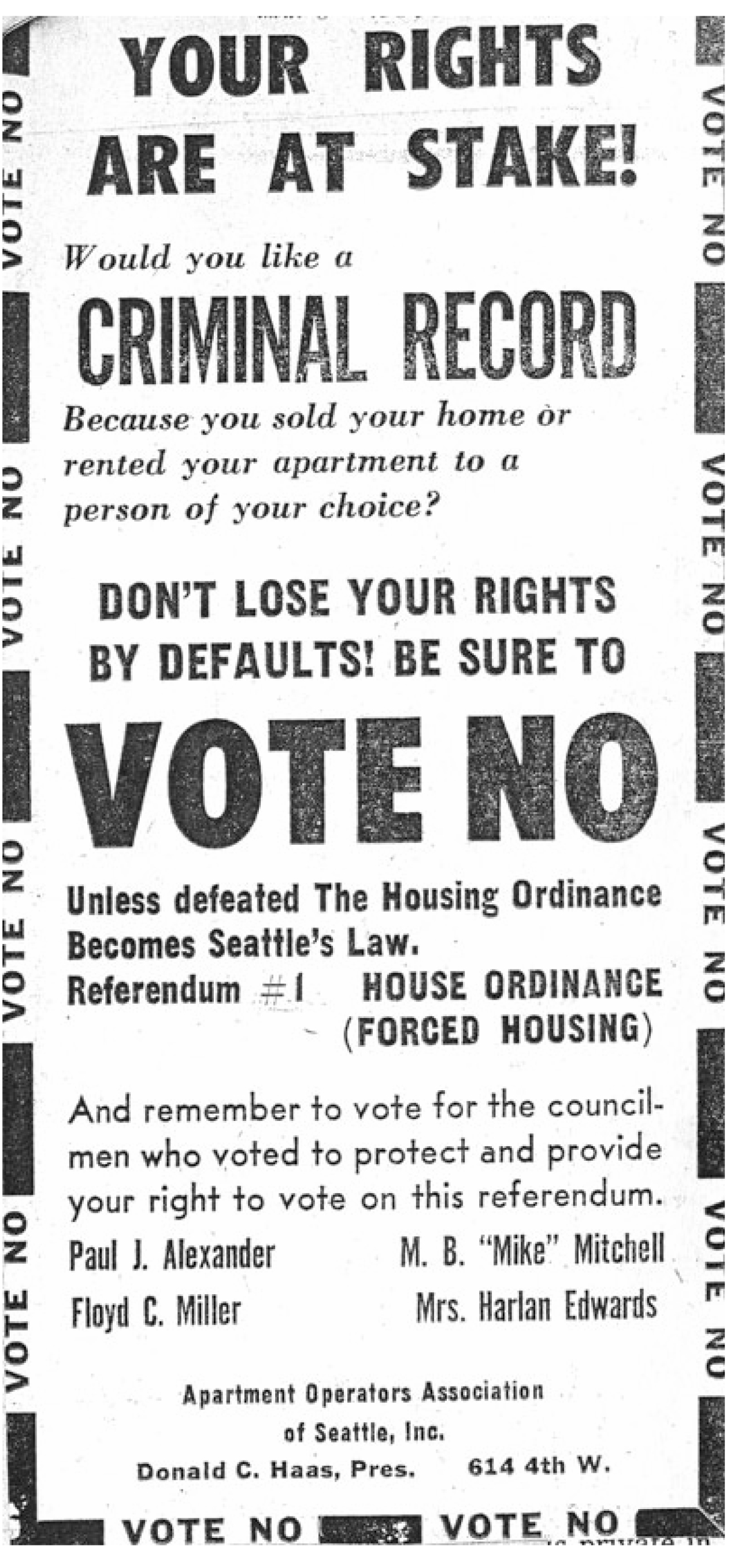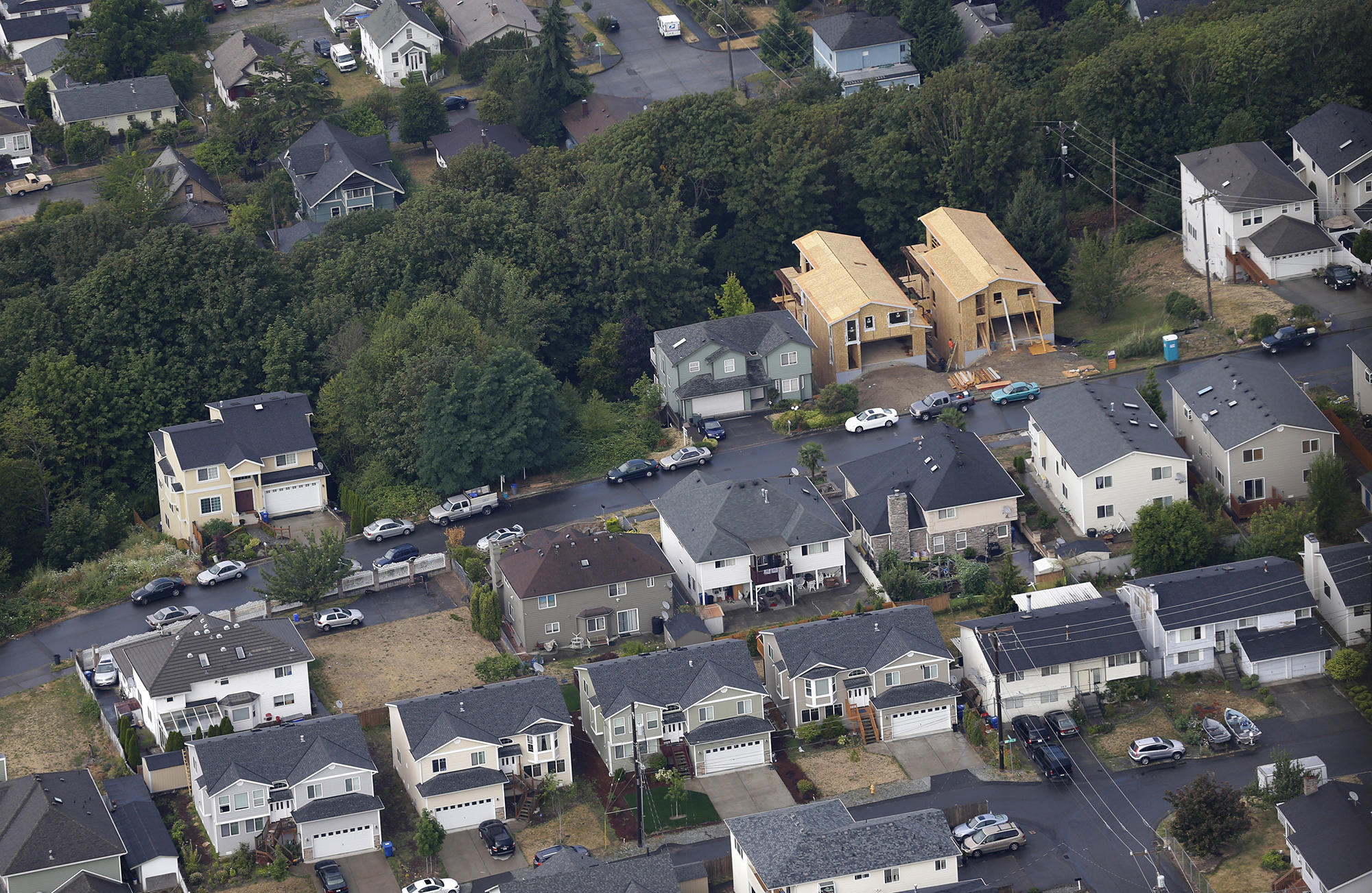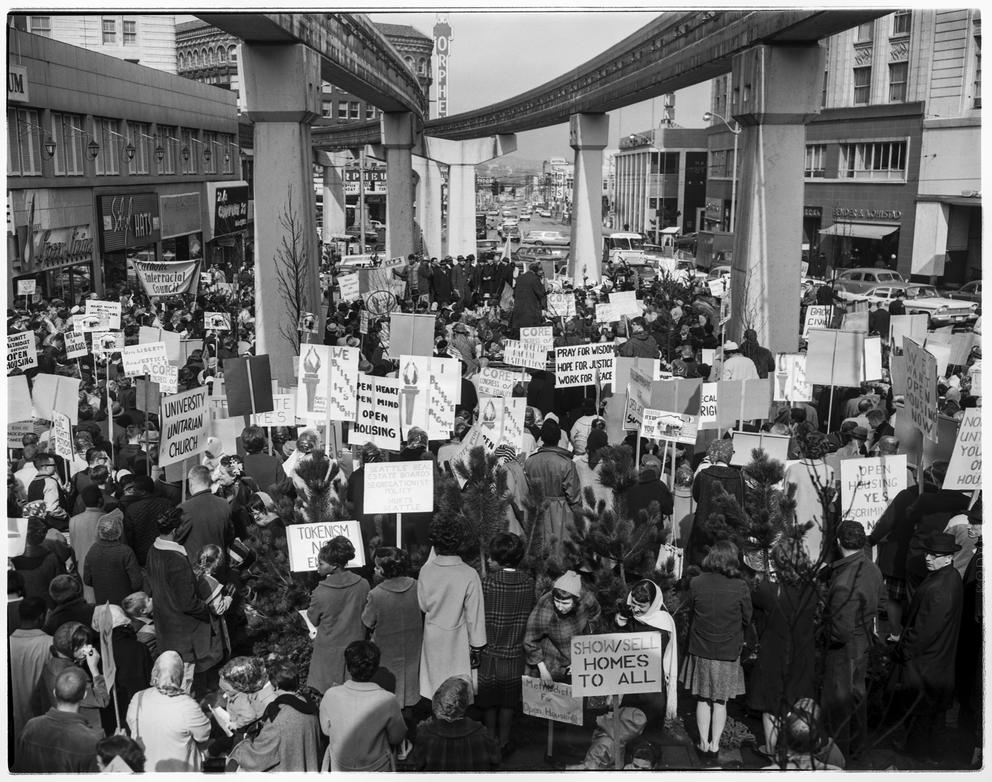But since a statewide shelter-in-place order went into effect in March, housing has been a paramount political problem in Washington, as well as its own solution; a political question of unprecedented urgency; and also the answer for homeowners, renters and the houseless alike.
Housing has been a problem for major liberal cities like Seattle before — arguably the main one. The difference is that our present circumstances have put the housing question to us in blunt terms: either ensure every Washingtonian is safe in their homes from economic insecurity, from pandemic, from police violence and from unbreathable air, or make explicit the implied inhospitality of our state to everyday people, once and for all.
Homesickness: Segregation in Seattle
The COVID-19 pandemic caused Washington Gov. Jay Inslee to institute a mandatory stay-at-home order on March 23, 2020. But longing for home was once a public health crisis.
In 1688, a Swiss medical student combined the Greek words nostos (“homecoming”) and alga (“pain”) to describe a malaise he observed in patients who lived far from home. Through the early 20th century, Western medicine applied the diagnosis of nostalgia primarily to convicts, immigrants, soldiers and enslaved peoples of African descent. Doctors believed symptoms of the disease included fever, malnutrition and stifling melancholy.
Just as COVID-19 quarantine has driven many to addiction, over-the-counter coping mechanisms often sufficed as treatment for nostalgia. In 1917, the pro-labor Seattle newspaper The Seattle Star raised $204.40 for a cigarette and chewing tobacco fund for soldiers suffering nostalgia in Europe during World War I. American Secretary of War Newton Baker proclaimed “on behalf of many a homesick soldier, the Department of War approves these gifts and the spirit of homely sympathy which inspires them.”
The first known use of nostalgia in its current sense — yearning for a bygone past — appeared in 1920. By then, the “Spanish flu” pandemic superseded nostalgia as a public health concern. Nonetheless, home remained a foundational political problem in Seattle. Waves of returning soldiers and the anticipated baby boom meant we had some decisions to make about what kind of city we wanted to be.
In 1920, Seattle officials invited urban planner and known segregationist Harlan Bartholomew to spend three days with the city’s Municipal Plans Commission. During World War I, Bartholomew successfully implemented a housing regime in St. Louis to, in his words, “preserve more desirable residential neighborhoods” and restrict the movement of “colored people into finer residential neighborhoods.” In Seattle, he helped the city draw “single-family zoning” boundaries that made the construction of apartments in most of the city illegal. The fear was that rental housing would bring social undesirables into Seattle’s increasingly prosperous postwar neighborhoods.
Historian Richard Rothstein writes in The Color of Law: A Forgotten History of How Our Government Segregated America that “social class elitism was an important motivation of neighborhood zoning rules.” When combined with racially restrictive housing covenants that banned people of color from buying property outside of the Central Area and South Seattle, single-family zoning segregated Seattle.
In a 2018 report, the same Seattle Planning Commission that segregated the city nearly a century earlier reversed course: “Changes to single-family zoning could create more access for people of color who were prevented from owning homes due to racial discrimination.”
To avoid dealing with the racism inherent in Seattle’s housing laws directly, proponents of single-family zoning often mask the truth. Years before President Donald Trump fiercely defended single-family zoning, Seattle Times columnist Danny Westneat wrote in 2015 that “single-family zoning … has for a hundred-plus years been the defining feature of Seattle’s strong neighborhood feel.” In an article that framed a mayoral task force on housing as some kind of backroom plot, Westneat declared suggested changes to single-family zoning as “dramatic,” and “some of the most sweeping changes in the way Seattle lives and grows ever proposed.”
Westneat’s framing is wrongheaded, and also factually wrong. Apartment bans didn’t become law in Seattle until 1923, well shy of the bogus “hundred-plus years” lifespan he gave them in 2015. If anything was “dramatic,” it was the sudden abolishment of apartment buildings in a city that was fine with them for several generations — until the city’s population of Black and Asian American residents grew at the end of World War I. Furthermore, Eastlake, Capitol Hill and the Chinatown-International District are historic residential Seattle neighborhoods that allow a range of housing options, none of which tarnish the “neighborhood character” façade that opponents of affordable housing often use to gloss over a past steeped in segregation.
Novelist L.P. Hartley once wrote that “the past is a different country.” It was a country where many were not welcome, and housing security was a dream deferred. Behind the reactionary discourse epitomized by the documentary “Seattle Is Dying” and coarse anti-homeless blogs like Safe Seattle is the fear that history has left behind the good old days of gated communities and widespread, whites-only prosperity. Too many city dwellers still believe home is a fragile fortress, besieged on all sides by the urban poor. By apartment buildings. And, above all, by changing times.
No vaccine was ever discovered for nostalgia.
The fight for fair housing
The fight to restrict access to housing has made our cities less inclusive. The right to expand it has made them more welcoming.
On July 22, 1963, 22 activists from ages 13 to 22 occupied Seattle City Hall for four days to protest housing segregation in the city. In response, Mayor Gordon Clinton established the Seattle Human Rights Commission, which drafted an “open housing” ordinance banning racial discrimination in housing. The bill included an emergency clause that would have allowed the Seattle City Council to pass it immediately.
But rather than pass the law — and brave the inevitable backlash from white homeowners — the city council cowered, and instead placed the bill on the ballot for a public vote. Segregationists successfully sabotaged public opinion about the ordinance by reframing it as a fight over property rights and homeowner preference, rather than racial justice. An anti-fair housing ad that ran in the Seattle Post-Intelligencer asked readers, “Are you willing to vote away your personal decision as to whom you lease your home?” Another that ran in The Seattle Times decried the “INTEGRATION FIASCO” in menacing bold letters. Meanwhile, powerful potential allies like the King County Labor Council refused to endorse the landmark anti-discrimination law. It was too much to overcome.
On March 10, 1964, Seattle voters emphatically embraced segregation by rejecting the open housing ordinance, 115,627 “no” votes to 55,448 “yes” votes.

Seattle didn’t outlaw racial segregation until April 19, 1968, following widespread protests after Dr. Martin Luther King, Jr. was murdered in Memphis, Tennessee. Needless to say, affordable housing is still scarce in Seattle. Because of apartment bans originally designed to keep people of color out of mostly white neighborhoods, apartments can now be built only in small pockets of “urban villages” in Seattle. The bottleneck has an inflationary impact on the rental market, making Seattle’s one of the most expensive among all American cities.
Washington has the 10th highest average monthly rent ($1,194) of any state in the country. But the median income here is only $5,762 per month. As a result, many Washington renters — and 47% of all Seattle renters, as recently as 2016 — spend more than 30% of their incomes on rent. That’s the Department of Housing and Urban Development’s official definition of being “rent burdened.” In June, Crosscut reported that 437,000 Washingtonians were using credit cards and short-term loans to cover rental debt.
Meanwhile, vulnerable Washington homeowners — people of color and seniors, in particular — are at acute risk of displacement. Counties in Washington state are allowed to collect a 12% interest rate on delinquent property taxes, and an additional 8% penalty in December of the year these taxes are due.

From left, Delores Hall, Jackie Ellis, Infanta Spence and Susan Van Dong participate in a sit-in to protest low African-American representation
on the Human Rights Commission (two of twelve members), at a Seattle City Council meeting, July 26, 1963. (Seattle Post-Intelligencer/MOHAI)
When housing can be obtained only with high wages, ample savings and access to credit, nobody suffers more than the houseless. A 2018 Zillow study indicated that for every $100 increase in average rents in Seattle, rates of homelessness tick up by 15%.
Washingtonians are spending more time than ever at home, or looking for it. If now isn’t the time to protect renters, vulnerable homeowners and the houseless, when is?
Answering “The Housing Question”
The search for solutions starts at home.
In the same way that localities could forgive all rental and mortgage debt incurred during the COVID-19 pandemic, Washington state legislators could reiterate House Bill 6314 by forgiving property tax delinquency incurred during declared states of public health or housing emergency.
Major cities across the state could ban forms of “hostile architecture” that discourage the relative comfort and congregation of our houseless neighbors. Washington state and especially King County — where more than 11,500 people are unhoused — could follow the lead of Seattle’s JumpStart Tax by taxing the wealthy and investing in housing and social services for the homeless.
As an amendment to the 1968 Open Housing ordinance, the Seattle City Council could, for the first time in its history, officially recognize the harmful impacts of exclusionary zoning laws. It could follow that resolution with concrete action by substantially expanding the size of “urban villages” in the city’s Comprehensive Plan, which guides the city’s big-picture decisions on the shape and substance of our neighborhoods.

Seattle’s Comprehensive Plan defines “urban villages” as “areas where dense, mixed-use, walkable communities offer a balance of housing and employment [and] a mix of goods and services,” like grocery stores, libraries, transit and child care facilities. Most of the world’s great cities don’t need a special designation for this kind of neighborhood; it’s simply the norm. But in too much of Seattle it seems like utopia, since our political decisions have for too long neglected the needs of a dynamic, diverse urban population. That can change.
Many elected officials in Washington — like Seattle City Councilmember Teresa Mosqueda and state Rep. Melanie Morgan — champion housing friendly, “housing first” policies. Yet at the same time that we search for legislative solutions to housing insecurity, more direct measures taken by everyday people must remain part of the equation.
In his 1872 essay “The Housing Question,” Friedrich Engels observed, “There are already enough buildings for dwelling in big towns to remedy the housing shortage. This can happen by expropriating the present owners and quartering workers and the homeless in vacant housing.” Perhaps the notion seems pie in the sky? In August, 50 Philadelphia housing activists employed exactly this strategy, eventually reaching an agreement with the Philadelphia Housing Authority to turn the occupied properties over to a community land trust. Similar efforts are afoot in Tacoma, with the organization Tacoma Housing Now taking possession of a vacant middle school and turning it into emergency pandemic housing.
Governments work on once-a-year budgets. But high rents and housing security are an everyday concern for citizens who have seen little relief from their own government.
Because of COVID-19, our collective living rooms have replaced our city halls and statehouses — our landmarks and public parks — as our civic commons. When we can congregate safely again remains unclear. But cultural responses to the pandemic contain a clue as to why simply building more homes isn’t the default solution to Washington’s housing woes.
In the same way that some have made mask mandates an abstract debate about “individual liberty,” housing has become a distracting referendum on “neighborhood character” for opponents of new apartment buildings. On “law and order” for city dwellers who believe apartment buildings will invite social undesirables into exclusive neighborhoods. On “fiscal responsibility” for elected officials who would rather see homeowners, renters and the houseless suffer than see the wealthy mildly inconvenienced with a moderate rise in taxes. At every turn, lofty-sounding ideals are elevated to prevent on-the-ground material progress.
To move past this rhetorical misdirection, we have to find our way home. We can get there by centering housing. Not as a luxury commodity for a privileged few — but as a social good for all.
A group of over 1000 protesters, led by Rev. Mance Jackson and other clergymen, marched quietly from Mount Zion Baptist Church in the Central District in an anti-discrimination "freedom march" through downtown Seattle, June 15, 1963. Organized by the Congress for Racial Equality (CORE) and the NAACP, the demonstration mainly concerned discrimination in housing, education, and employment, as well as the city government's failure to address that discrimination adequately. (Seattle Post-Intelligencer/MOHAI)




